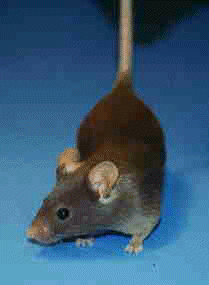

First, I should explain some vocabulary.
Second, I want to mention some basic principles of genetics that will aid in understanding the mapping of disease genes.
There are two tools that are very useful for this type of genetic analysis.
There are hundreds of different strains of mice. Because the mice have been inbred for many generations (at least 20, but usually many more than that), all members of a given strain are genetically identical - like identical twins! But the strains differ among each other in their genetic makeup.


These strains also differ widely in their phenotype. For instance, using cancer as an example, some strains are very sensitive to getting liver tumors and each mouse from that strain will get at least 50 tumors whereas some strains are resistant to developing liver tumors and will get less than 5 tumors per mouse (on average).
We start out by proposing the Hypothesis that there is one gene that has a very strong affect on the phenotype (in this case, a large number of liver tumors).
If our hypothesis is true, then a mouse strain which is susceptible to liver tumor induction would carry a sensitive allele of the gene and a strain that is resistant should carry a resistance allele of the cancer gene. In order to do our analysis, we need both a phenotype and a genotype.
The phenotype is the number of tumors observed in an individual mouse.

The genotype is whether the mouse carries two sensitivity alleles, two resistance alleles, or one of each allele for the cancer gene. For example, let's desginate the sensitivity allele as "T" and the resistance allele as "t". (Remember, each mouse has two copies of the gene.) Thus, the sensitive strain would have the genotype "TT" and the resistant strain would have the genotype "tt". Using some simple Punnet squares, we can predict the genotypes of offspring from the mating of different strains.

The twist of this problem is that we have no idea where the gene is located when we start. But based on our calculations, we would predict that we can find the gene by looking for the chromosomal region in which all of the mice that have a lot of tumors carry two "T" alleles.
Another way to say it is, that all of the mice that carry a "T" allele should get a lot of tumors. The cancer gene should be located near the region where all of these mice carry alleles from the sensitive parent.
An example is shown below:

As you can see, only marker number 3 correlates with the phenotype of sensitive and resistant. By observing this sort of correlation in large samples of animals, we can be confident that there is a tumor sensitivity gene located near the genetic marker on the chromosome.
Our laboratory has mapped several genes that predispose mice to liver cancer. We are in the process of trying to characterize these genes and determine their function. Once we figure out how they are affecting cancer formation in mice, we can determine whether they have the same role in the formation of human cancer.

Return to T. Poole's home page.